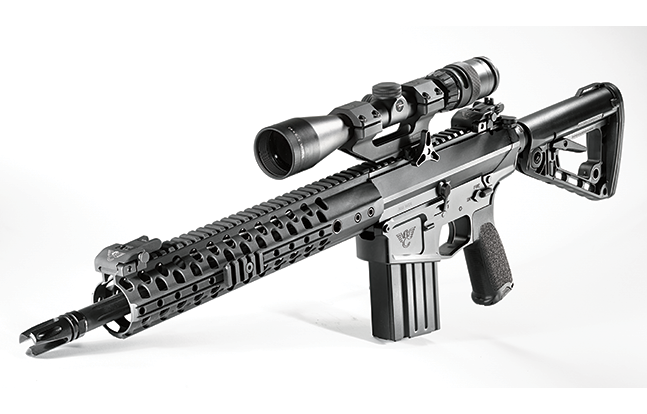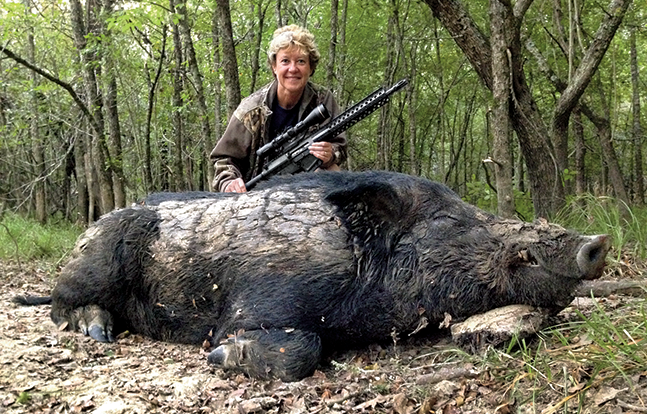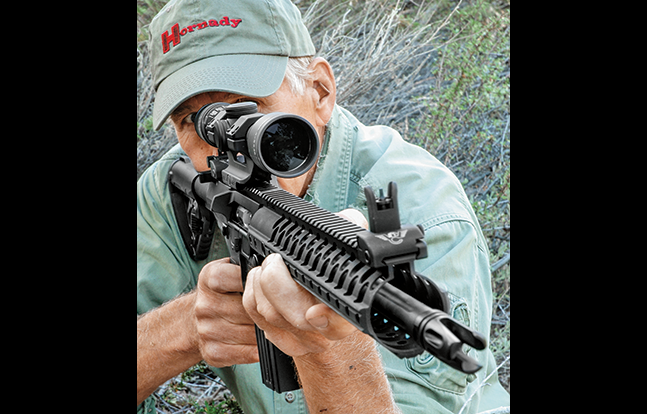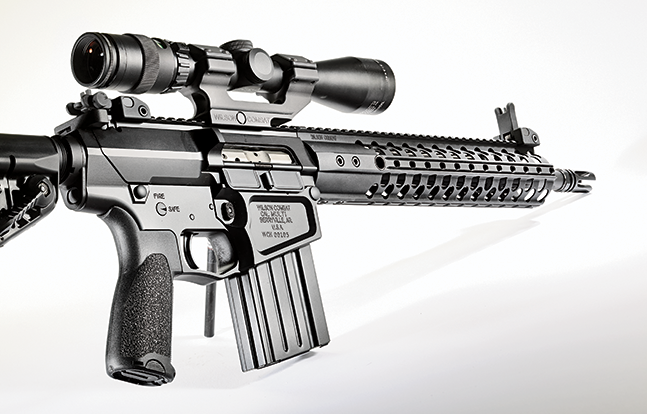After a couple of days chasing feral hogs through Texas thickets, I came to appreciate not only the punch of the .458 SOCOM, but also the short barrel and fine balance of Wilson’s AR. His carbines in .223 Remington and 7.62×40 WT delivered the same accuracy with less recoil. While I once thought all ARs differed by as much as the shade of black on their uppers, I was struck by the fine machining and detailing on Wilson Combat’s. They’re artfully crafted and finished. Their triggers are more tractable than those on many bolt guns. And Wilson self-loaders cycle with Swiss-watch precision. “One failure leaves a bad taste,” he said. “Our rifles don’t fail.”
- RELATED: Gun Review: Wilson Combat’s Rifle Warriors
- RELATED: Gun Review: Wilson Combat’s Paul Howe Tactical Carbine
So when I learned that Wilson Combat had made the logical next step to a .308-sized AR action, I jumped at the chance for a first look. The BILLet-AR Lightweight .308 arrived in one of Wilson’s nicely fitted, well-padded gun cases with built-in magazine pouches. That case, with a test target, is part of every package.
Advertisement — Continue Reading Below
BILLET-PROOF BUILD
The upper and lower receivers on this rifle are machined from a billet of 7075-T6 aluminum, and they look it. Wilson Combat firearms have the look of perfectly cut diamonds. The flats are ripple-free, edges crisp, the seams airtight and uniform. The metal finish on this rifle is Wilson’s Armor-Tuff in satin black. Other color options are available, too.
“It is short and powerful and has the compelling profile of a firearm that’s all muscle.”
Advertisement — Continue Reading Below
This .308’s 1-in-10-inch-twist barrel is short: just 14.75 inches. The pinned and welded flash suppressor brings it to a non-NFA length of 16 inches. Wilson is now button rifling its own barrels; they’re scheduled for production runs of the .308. The forend tube has an integral top rail that abuts the receiver rail for a full-length platform. The tube is drilled and grooved at 3, 6 and 9 o’clock so you can attach more rails for more accoutrements. But until you do, this forend is comfortable to hold and no heavier or bulkier than it needs to be. Wilson lists a bevy of attachments for its rails. Most of these are made in-house, like the folding front sight and adjustable, flip-up rear aperture. There’s a wide aperture for fast shooting in poor light. Rock the sight 90 degrees, and you have a square notch over a small “peep.”
The test rifle came with a clever one-piece alloy mount/ring assembly (an option). It bears for 2.5 inches on the rail but has just one star-shaped tightening nut that spins snug with your fingers. It’s easy to use but not obtrusive. Installing or detaching a scope in this mount is quicker than a mule’s kick. I used a Trijicon 3-9x40mm AccuPoint scope for my range work. This illuminated sight looked right at home in the beefy, four-screw Wilson rings. Its ocular housing cleared the rear aperture by 0.2 inches. The scope aligned instantly with my eye when I cheeked this rifle.
Wilson fitted a Rogers Super-Stoc behind the lower. It’s a well-machined, six-position, skeleton-style buttstock with an adjustment lever. It can also be locked in place with an offside lever. The length of pull can be adjusted from 11.38 to 14.38 inches.
Advertisement — Continue Reading Below
The vertical grip is full enough for my big hands and neatly stippled. A trapdoor in the bottom swings open with a pinch, so you can store items inside. The rifle’s fire controls are standard, intuitive and easy to reach. There’s no forward assist. The single-stage trigger is Wilson’s, and the pull weight on my test rifle came in at 3.75 pounds, plus or minus 4 ounces. It’s quite controllable, with less take-up than most ARs I’ve used.
This AR has a direct-impingement (DI) gas system. It’s simple and reliable and incrementally lighter in weight than piston-driven rifles. In tests at Wilson Combat, DI rifles also gave slightly better accuracy. The one criticism of DI systems, that they run a bit dirtier, is countered in this rifle by coating the bolt and carrier with NP3, which combines tiny particles of polytetrafluoroethylene (Teflon) with electroless nickel to yield a plating hardness of 49 to 51 Rockwell. The lubricity is so high that there’s no need for lube that gathers grit. NP3 is also corrosion resistant, enduring 240 hours of salt spray in testing. I must say that the .308’s bolt runs very smoothly, cycling like a racecar piston.
Advertisement — Continue Reading Below
Unleashing The Beast
Partly because it’s so short and carries no extra weight, this Wilson feels more like an AR-15 than a large-frame rifle. At the range, I laid it across my Caldwell bag. The first shot at 35 yards struck near center, so I moved the target immediately to 100 yards. With five types of ammo, three-shot groups averaged 0.85 inches. This rifle functioned perfectly with every load. Even Big Green’s 125-grain Managed Recoil cycled without a hitch, turning in a 0.9-inch group. Hornady 150-grain American Whitetail rounds punched the best group: 0.5 inches. Black Hills’ Gold 165-grain Ballistic Tips came in at 0.8 inches, while 175-grain SMKs in Federal and Setpoint loads averaged an even inch.
This .308 rifle is a champ in the hand. It’s nicely balanced and “palm friendly.” Everything works as it’s supposed to, and the targets show it to be more accurate and less fussy than most bolt-action rifles in my collection. The rifle is short and powerful and has the compelling profile of a firearm that’s all muscle.
Advertisement — Continue Reading Below
For more information, visit wilsoncombat.com or call 800-955-4856.
Editor’s Note: This rifle is so new that the only true tests on game so far have been conducted by Bill and Joyce Wilson on big Texas hogs. As this issue went to press, a true release date for the rifle had not been determined. Stay in the loop by visiting www.tactical-life.com.
Advertisement — Continue Reading Below


























